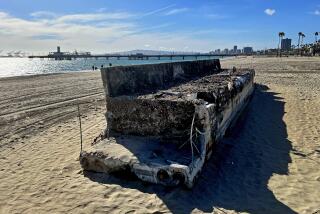Flood-Ravaged Midwest Must Get Rid of Millions of Filthy Sandbags
ST. LOUIS — There was no arguing about the need for sandbags when rain-swollen rivers surged over their banks and swamped homes and businesses, roads and government buildings throughout the Midwest.
There is, however, plenty of debate about what to do with the tens of millions of sandbags--all tied, filled and piled high at a fever pitch--now that the Missouri and Mississippi rivers and their tributaries are receding.
The U.S. Army Corps of Engineers alone produced 15 million sandbags.
Now, Des Moines, Iowa, St. Louis and hundreds of other communities that were begging for the 30-pound lifesavers only weeks ago are working nearly as hard to get rid of the smelly, polluted sacks of sand before they decompose.
“We were moving 100,000 sandbags at once when they were a valuable commodity,” said Michael Bello, street maintenance superintendent in St. Louis. “They’re trash now, and a hell of a problem.”
The determination to dispose of the sandbags, as well as mountains of damaged furniture, chemical containers, logs, dead animals and rotting food heaped on the Midwestern flood plains underscores how relief efforts have evolved from crises response to cleanup in a matter of days.
Anticipating overflowing landfills and illegal trash fires, state officials are trying to strike a balance between protecting the public from water and air-borne diseases and sending toxic pollutants into the atmosphere.
“Although we prefer that Missourians place debris in landfills, we realize that will not always be feasible with the volume of debris that will be generated by the flood,” said David Shorr, spokesman for the Missouri Department of Natural Resources.
“We know people are going to burn whether we like it or not, so we have temporarily relaxed our restrictions on burning driftwood, for example, which can attract vermin and insects,” Shorr said. “But we don’t want anyone burning plastics, tires, chemical containers or painted wood.”
As for sandbags, officials are hoping to use as many as possible for landfill in projects ranging from airport runway expansions to road gradings. The rest are most likely to end up in sanitary landfills, abandoned rock quarries and designated natural depressions.
This year’s flooding contributed to the deaths of 48 people and left as much as $15 billion in damage. Preliminary surveys indicate that the federal tab for cleanup, repairs and relief could total at least $7.5 billion.
In St. Louis, where the confluence of the Mississippi and Missouri rivers is expected to remain high for another month, “debris is going to be a bigger issue than we’ve ever known it to be before,” said Jim Brown, spokesman for the Army Corps of Engineers.
It’s already a public relations dilemma for street maintenance crews in St. Louis, who were on orders to restrict sandbag removal efforts to city-managed streets, bridges, levees, parks and buildings.
“We won’t remove sandbags from private property, that’s the property owner’s responsibility,” Bello said. “We’ll get angry calls . . . but we are going to just say no.”
St. Louis resident Ed Macarthy, who spent two weeks and $4,000 building a 13-foot-high wall around his home with 46,000 sandbags weighing 600 tons, had a serious problem with that policy.
“It’s just rubbish now and it would be an astronomical cost for me to haul it away,” the 62-year-old retired firefighter said. “I’m going to put them out on the first Monday of the month--a trash pickup day with no restrictions. If they refuse to take them, it’s their problem.”
Responded Bello: “We’ll see about that.”
Three hundred miles to the north in Des Moines, which has had more time to dry out, city officials have waved landfill fees as part of an effort to expedite cleanup work.
“The price paid for waving those fees will be used-up landfill capacity,” said Des Moines Deputy City Manager Rick Clark. “We had an extremely large amount of waste material disgorged from 300 businesses and 500 homes completely destroyed in the flooding.”
In Des Moines’ devastated Valley Junction area, nothing has changed but the weather for Rebecca Halton, her husband and three young boys. A month after nearby Raccoon River topped a levee and carved a hole in the living room floor, cracked a sewer line in the basement and lathered the walls in slime, the Haltons are living on donated mattresses in a back bedroom.
Like hundreds of other families in the neighborhood, they already have stacked their damaged belongings on the sidewalk to be hauled away to a landfill.
“I spend most days driving up and down the street looking for another place we can afford to rent, but the market is tough right now and the prices are unreal,” said Halton, 30, who has applied for federal aid.
More to Read
Sign up for Essential California
The most important California stories and recommendations in your inbox every morning.
You may occasionally receive promotional content from the Los Angeles Times.











